The Tiger in India – A Natural History
By J. C. Daniel
‘The Tiger in India – A Natural History’ by the former curator of Bombay Natural History Society, Late J. C. Daniel is a compilation of information gleaned through the thousands of posts from the journals of the Bombay Natural History Society and presents the interesting ones.
Mr. Daniel has taken pains to segregate the information into various chapters based on the origin, various races, distribution and population, physical characteristics like colour and size, senses, habit and habitat, interaction with other denizens of the forests as well as interaction with man. A keen student of tiger would easily get lot of knowledge which is not possible otherwise as there has been a lot of change in circumstances and getting such experiences in the wild has become nearly impossible.
Walking/ Tiger Tracks
In the old days there were confusion about the tigers walking as there used to be differences in the distance between the track marks of fore and hind legs and at times the tracks were overlapping. The author quotes F.W. Champion and Dunbar Brandar.
Dunbar Brandar writes “If the tiger progresses more slowly, or with purposeful caution, the gap decreases, and in following up pug marks along a nala one comes on places where the tiger has been obviously ‘interested’ or has rounded a corner with great caution. In these circumstances one comes on places where the hind leg on the same side has been placed exactly over the spot vacated by the forefoot. Of course, this action reduced the speed and noise. It is possible that a tiger, hungry and hunting, might continue this action over some distance, but it is not the tiger’s carefree, habitual action, it is controlled and purposeful action”. (page 99)
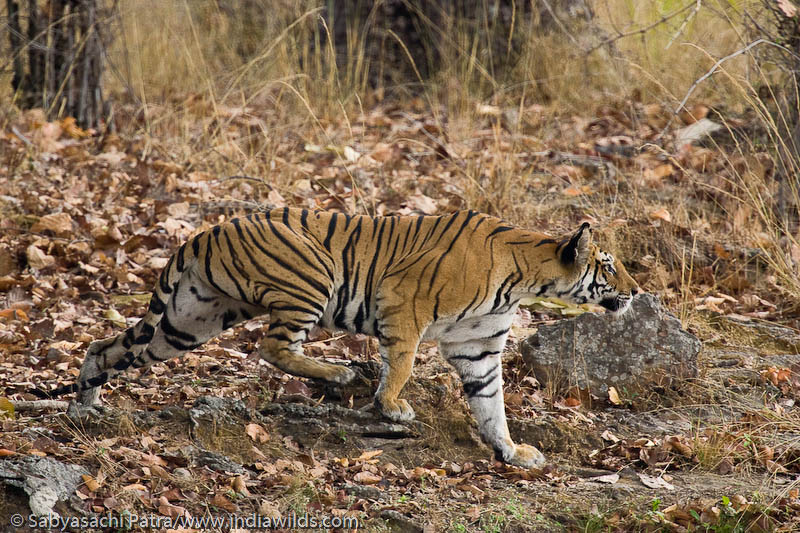
A wild tiger stalking its prey in Bandhavgarh National Park, india. The hind leg falls exactly at the same spot where its foreleg is, to minimise noise due to rustling of leaves.
Excellent Swimmers
Tigers are fond of water and during summers can be found lying in water to cool themselves. They are excellent swimmers and can cross great distances.
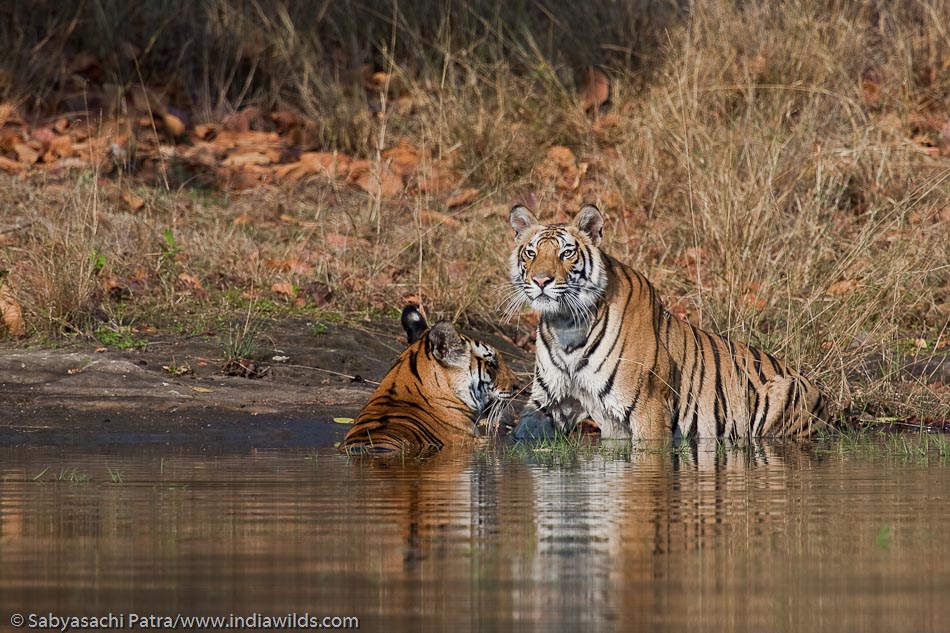
The wild tigress panthera tigris tigris gets out of water on the first signs of danger in Bandhavgarh National Park, India whereas the cub continues to cool off
K. M. Bataye mentions an incident where a tiger appears to have purposefully kept his kill in a deep pool. “A tiger had killed a ‘boda’ (buffalo calf) close to the bank of a river, some fifty yards wide, which flows into the Narbudda. …I found that the carcass of the ‘boda’ was floating in the centre of the river…I had no means of collecting the carcass from the pool, which was deep and probably contained at least one mugger, and the ‘Korku’ with me preferred to trot back to camp and bring another live ‘boda’ than venture into the water. …. At about 9 pm. I heard the tiger approaching noisily over dead leaves, and expected it to attack the live ‘boda’ any minute. Instead, it walked down to the river bank, swam out to the carcass and returned to the bank with it slightly slower down stream, out of view of the machan. The tiger left the carcass which still contained the stomach and intestines during the early hours of the morning, but when it became light the carcass was again in mid-stream”. (Page 100-101)
P. Garga writes “The nearest to Sunderbans one could set from within the district of Midnapur was at Khedgeree in Contai Subdivision 18 miles across the river Hooghly, to what is now known as Frasergunj, which is at present devoid of any jungle. But even until 1922, while the deforestation in progress was incomplete, tigers cross this 18 mile wide fast flowing river and were killed by the villagers at Khedgeree”.
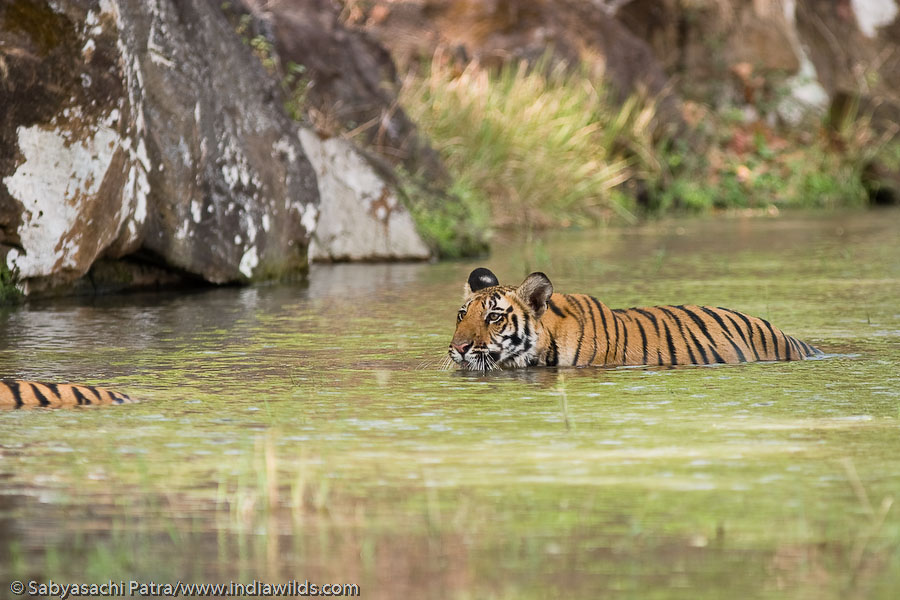
Wild tiger cub swimming behind its mother in water in Bandhavgarh National Park, India. Tigers are excellent swimmers.
J. C. Daniel has compiled several incidents reported about tigers young and old climbing a tree.
Smell and hearing
Tigers have acute sense of hearing. However, their sense of smell has been accepted as rudimentary. The author quotes Dunbar Brandar about his experiences with a pet tiger. “Some years ago I had the good fortune to procure a young tiger which I reared under the most natural circumstances and which used to run about loose in camp with the dogs. The following experiments were often repeated. His food, say a pig’s leg, would be taken away from him and hung up so as to be some seven feet off the ground, and when the tiger was led under and past it he seemed to be quiete unaware of its presence. Again, when he had carried off his “joint” to the surrounding grass, I have taken him off it, and shifted the joint, trailing it along the grass. The tiger would return to the exact spot where it been, and then proceed to hunt round in circles for it, he never followed the scent, and what is more significant never attempted to. Wild tigers find a shifted “kill” in exactly the same way if it was out of sight. I consider that these experiments prove that the tiger’s sense of smell is less than that of man, and a tiger has failed to scent me under circumstances which, had they been reverse, would have enabled a man endowed with ordinary powers of smell to discover a tiger”.
Mating Behaviour:
J. C. Daniel quotes lot of valuable data from an article by A. K. Das about tiger reproductive behaviour as observed in captivity. “The duration of gestation period in the present observation has been estimated as the period from the last day of mating to birth, and the mean period was 103; and the maximum and minimum were 107 and 101 days respectively. In Calcutta Zoo, seven tigresses mated with the males in 48 heat periods from 1965 to 1977. Out of 48 mating or heat periods, pregnancy occurred in 22 cases and did not occur in 26 cases. The percentage of pregnancy is, therefore, 45.8% only and non-pregnancy is 54.2%. It was observed that the number of heat periods and percentage, of pregnancy were less when both sexes lived together except at night”.
Methods of killing prey
The method of killing prey is an oft discussed topic. Some hunters who have watched tiger kill live buffalo baits protest that neck dislocation is not the usual method of killing employed by a tiger where as others vouch for it. J. C. Daniel has culled various points of view for and against it, written by various sports persons from the pages of the BNHS journal.
The valedictory chapter of the book talks about the struggle for survival. It tells us the story of E. P. Gee’s estimates of tiger and other wildlife numbers from E. P. Gee’s book “The Wildlife in India” published in 1963. The estimates of wildlife numbers were from the present population of that time as well as those 50 years ago.
The author nicely summarises the predicament about tiger conservation when he says that “The tiger is probably the species which has received the most publicity, and had more money spent on efforts for its conservation than any other species of Indian wildlife. Yet the tiger keeps sliding towards extinction. Apparently, it is not a sudden process but has been accelerating in the last fifty years”. Peter Jackson and Elizabeth Kemf wrote, in the 1999 WWF Species Status Report, that “since the turn of the century its habitat and numbers have been reduced by 95 percent. For a million years the ‘King of the Jungle’ lorded over a territory extending from eastern Turkey to the Russian Far East, its forest home extending northward to Siberia and southward into Bali. In this century alone the Bali, Javan and Caspian tigers have become extinct. Tragically, the remaining five subspecies are at risk of meeting the same fate”.
The author J. C. Daniel ends his book by writing “How long the tiger will survive in the new millennium depends on how intelligently the problems facing its survival are managed. Judging from the present achievement, the future is bleak”.
This book is highly recommended not only for the scholars and researchers who are looking at additional information and data, but also for the budding wildlife enthusiasts to get valuable info. The book is easy reading and since it talks about a bygone era, even layman will find it interesting to read.
I had bought this book when it was first published in 2001. This hard bound book published by Nataraj Publishers contains 300 pages and is priced at 495 rupees. One can order directly from the Publishers or hunt for it online.
Amazon India Link:
- GoPro Hero 12 Black - 6 September,2023
- Leopards: The Last Stand - 2 July,2023
- Drifting in the Waters of Sundarbans - 26 March,2023


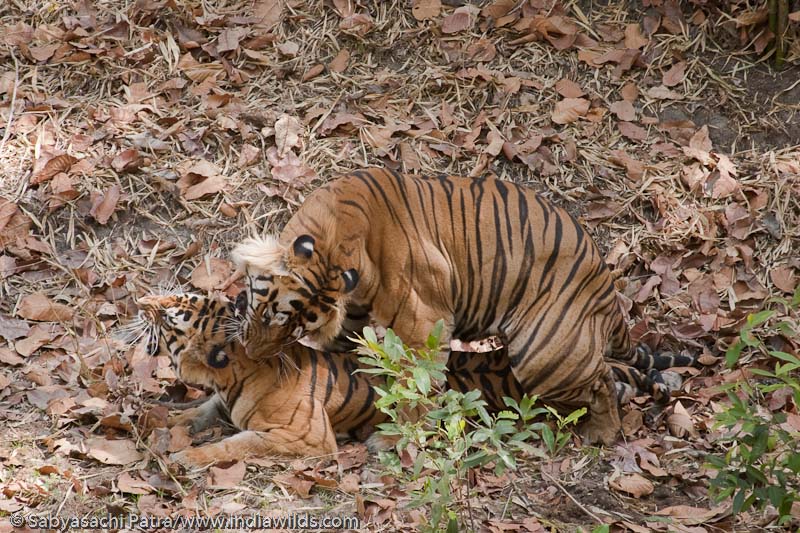
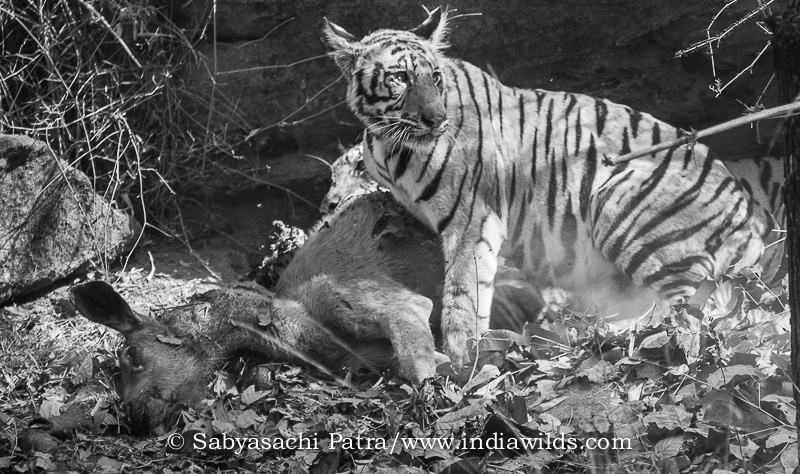








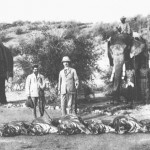




Captivating shots and video.
Sabyasachi, your images and videos are a little more than breathtaking. I am astonished at the crystalline quality of the stills. I loved the intriguing ways in which a tiger might move, their playfulness in water et al, as described in the book under review. I am sure I feel inclined to buy this book. Thank you for the uber class enrichment.